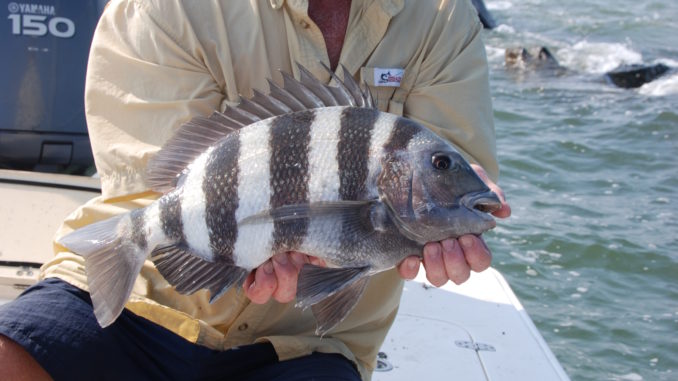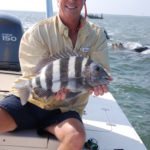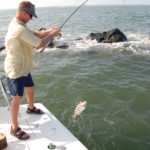
Throughout history, a number of unscrupulous characters have made their way into Charleston Harbor, but these ‘convicts’ may be some of the hardest to catch.
Johnny Spitzmiller stood on the bow of his boat, gripping the controls of his trolling motor like a man bent on trying not to crash into the nearby rocks — which he was barely succeeding in doing. Despite what appeared to be a dire situation, he was calm and actually upbeat as he explained his predicament.
“Basically, it’s all about water temperature,” Ambush Inshore Charters’ Spitzmiller said. “It’s about water temperature that has been 70 degrees for a couple of weeks — 70 degrees is the magic temperature.
“When you hit 70, the sheepshead move into the jetties from the nearshore reefs.”
Once the water flowing into Charleston Harbor from the ocean reached that magic mark, Spitzmiller and Marc Deschenes (a part-time guide who often works for Spitzmiller) start working the rocks to find the fish.
Finding sheepshead is a matter of sight-fishing, motoring along the rocks looking for a glimpse of black-and-white flash in the current wash.
“Sheepshead are a schooling fish,” Spitzmiller said, “so if you see one fish, chances are there are more in the area. You’re most likely to see them near the surface, eating barnacles off of the rocks. You can actually see them turn sideways and eat the stuff off the rocks in the jetties.”
Spitzmiller suggested two options for getting within rod reach: putting an angler on the bow and motoring along the edge of the rocks, or anchoring close to the rocks and fishing vertically.
Either way, when you see fish you need to start fishing.
“I’m on the bow of the boat. I’m keeping (it) off the rocks with the trolling motor, and that allows my clients to fish from the back end of the boat where they can reach the rocks,” he said.
“Another way to fish the jetties is to stay on that upcurrent side of the jetties and throw one anchor off the back of the boat out in deep water, and then idle up to the rocks and throw a brick in the rocks and pull tight. That way, you’ve got your boat stable with two anchors. Throwing the brick up in the jetties keeps the front end from swaying back and forth. Then we get the rods out and jig a fiddler crab along the edge of the rocks.”
Current and tides play a major factor in when and where sheepshead feed. Deschenes said the more water there is on the rocks, the better the fishing.
“Sheepshead feed on the incoming tides better than the outgoing tides,” he said. “The reason is that, as that tide comes up, water hits more of the barnacles on those rocks, and the food they eat — barnacles, crabs and shrimp — are up on those rocks. The more rocks that are in the water as the tide gets higher, the more food the fish have to eat.
“They’ll get right on top of those rocks and eat the barnacles right off the rocks.”
Though it sounds simple, each of the two jetties lining the entrance to Charleston Harbor is nearly four miles long.
It helps narrow down the options by being able to identify the “seams” in the jetties that are most likely to attract sheepies.
“It works best for me where the water is flowing through the jetties,” said Spitzmiller. “It is key to look for areas where water is rushing through the rocks like a river — where it’s busting through different-size rocks on the jetties. Unfortunately, it’s those places where the current is pulling your boat toward the jetties, but it’s also pulling your bait towards the jetties.
“When you flip that fiddler crab in there, you want it pulling your bait into the rocks where the fish feed.”
Spitzmiller warns that if you are anchoring to fish, you are going to spook them when you throw a brick anchor into the rocks. But be patient, as the fish will come back. He said it takes about 10 minutes for things to settle back down.
Then it’s just a matter of loading the fish box with fish and heading home.
Nice thought, but hardly the way things work with sheepshead, which didn’t get the nickname “convict fish” by playing fair.
Sheepshead are adept at stealing bait from a hook with barely a thump or wiggle of the line.
Spitsmiller’s first line of defense is the tackle he uses.
“The best sheepshead rig I have is a medium-action, 7-foot spinning rod with 8-pound-test line,” he said. “Anywhere from 8- to 12-pound-test line, with a No. 6 Owner hook — which is a really small hook — with one small splitshot.
“The size of the splitshot will depend on the current, but the key is to have that crab sink ever so slowly so it looks natural, you want to get the bait to the bottom with as light of weight as you can get away with.”
Though sheepshead are often compared to freshwater panfish, albeit three to five times the size of their inland counterparts, the comparison is closer to a shellcracker than a crappie or bluegill, primarily because sheepshead don’t feed up; they feed down.
“The bait needs to be sitting down on the bottom or on a rock,” he said. “You will never see a sheepshead come up to get a bait. You flip that crab to the fish and, even though you might see the fish and think he’s going to eat it, what typically happens is the fish heads down, following the crab to the bottom. He will follow that crab to the bottom before he’ll pick it up. Up top what you have to do is keep the bait real still while he picks it up. You won’t see it happen, but he will get it.”
Even in those opportunities of sight-fishing, once a fish heads to the bottom after your bait, a disconnect may still exist about when to set the hook — or rather how to set the hook.
“That’s the toughest part, he said. “It is a fine line between keeping your line tight and not moving it,” Spitzmiller said. “When you get that mastered, all it does is get heavy. Once your line gets heavy, he’s got it. At that point, you just lift. You do not set the hook on a sheepshead.
“The best way I can describe it is you are pulling the fish off the rock.”
Another Spitzmiller secret is the small hook he uses, small enough to hide in the bait.
“I use either a No. 4, 6 or J-style hook,” he said. “People wonder why I suggest to use such a small hook, but you want that sheepshead to eat that fiddler crab, and you want him to not realize that there is a hook in it.”
For anglers who have spent so much time and effort figuring out the patterns and eating habits of sheepshead, it would stand to reason that Spitzmiller and Deschenes would have dozens, maybe even hundreds of hot sheepshead spots.
Not true, because neither cares much for the typical boat dock, pier piling or random rock piles prevalent up and down the coast: The jetties are the only sheepshead destination in their playbooks.
“Johnny and I only fish at the jetties because of the quality of fish,” Deschenes said. “If you fish boat docks, you are typically not going to get anywhere near the quality of fish that we get off the jetties.
“Out there, you will find fish anywhere in the 2- to 9-pound range. It’s not uncommon to catch a couple of 8- and 9-pound fish on any trip you go. on”
DESTINATION INFORMATION
WHEN/WHERE TO GO — Sheepshead start showing up on the Charleston Harbor jetties around the first of May. They show up in good numbers that last half of May and into June, and they’ll stay on the jetties until November, or when the water temerature drops back below 70 degrees. The Charleston area has a number of public boat-access areas, there of which are convenient to the jetties: Remley’s Point on the Wando River, off County Road 56 just north of US 17 in Mount Pleasant; Shem Creek off SC 703 on Shem Creek in Mount Tabor; Wappoo Cut off SC 171 near the intersection of SC 171 and SC 700 on Wappoo Creek.
TECHNIQUES — Fish the top six hours of the tide cycle — from three hours before high tide to three hours afer. Flip fiddler crabs or shrimp on light spinning tackle and small hooks into the rocks, using your trolling motor to keep you a safe distance from the jetty or by anchoring. Baits can be jigging vertically or tight-lined on the bottom — floating them under a cork is a third alternative.
FISHING INFO/GUIDES — Capt. Johnny Spitzmiller, Ambush Inshore Charters, (843) 971-0537 or www.ambushinshorecharters.com. See also Guides & Charters in Classifieds.
ACCOMMODATIONS — Best Western Patriots Point, 259 McGrath Darby Blvd., Mount Pleasant, 29464-2983, (843) 971-7070; Town and Country Inn & Conference Center, 2008 Savannah Hwy, Charleston, 29407, (800) 334-6660; La Quinta Inn & Suites, Charleston Riverview, 11 Ashley Pointe Dr., Charleston, 29407, (843) 556-5200.
MAPS — Maps Unique, (910) 458-9923, www.mapsunique.com; Sealake Fishing Guides, (800) 411-0185, www.thegoodspots.com.









Be the first to comment